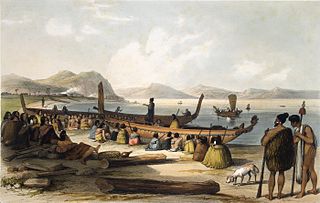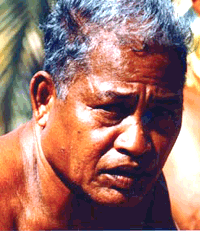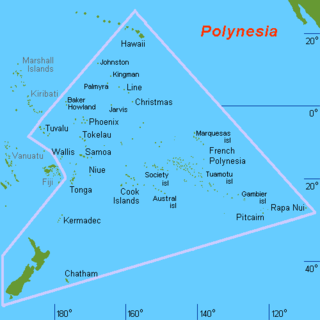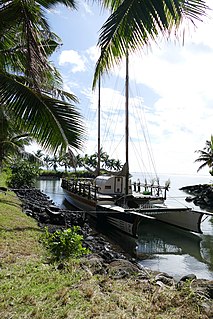
Rarotonga is the largest and most populous of the Cook Islands. The island is volcanic, with an area of 67.39 km2 (26.02 sq mi), and is home to almost 75% of the country's population, with 13,007 of a total population of 17,434. The Cook Islands' Parliament buildings and international airport are on Rarotonga. Rarotonga is a very popular tourist destination with many resorts, hotels and motels. The chief town, Avarua, on the north coast, is the capital of the Cook Islands.

The Polynesian Voyaging Society (PVS) is a non-profit research and educational corporation based in Honolulu, Hawaiʻi. PVS was established to research and perpetuate traditional Polynesian voyaging methods. Using replicas of traditional double-hulled canoes, PVS undertakes voyages throughout Polynesia navigating without modern instruments.

Hōkūleʻa is a performance-accurate waʻa kaulua, a Polynesian double-hulled voyaging canoe. Launched on 8 March 1975 by the Polynesian Voyaging Society, she is best known for her 1976 Hawaiʻi to Tahiti voyage completed with exclusively traditional navigation techniques. The primary goal of the voyage was to explore the anthropological theory of the Asiatic origin of native Oceanic people as the result of purposeful trips through the Pacific, as opposed to passive drifting on currents or sailing from the Americas. DNA analysis supports this theory. A secondary project goal was to have the canoe and voyage "serve as vehicles for the cultural revitalization of Hawaiians and other Polynesians."

Waka are Māori watercraft, usually canoes ranging in size from small, unornamented canoes used for fishing and river travel to large, decorated war canoes up to 40 metres (130 ft) long.

Tikopia is a high island in the southwestern Pacific Ocean. It forms a part of the Melanesian nation state of Solomon Islands but is culturally Polynesian. The first Europeans arrived on 22 April 1606 as part of the Spanish expedition of Pedro Fernandes de Queirós.
Sir Thomas Robert Alexander Harries Davis was a Cook Islands statesman and medical researcher. He served as Prime Minister of the Cook Islands from 1978 to March 1983, and again from November 1983 to July 1987. He also worked as a medical officer, and as a medical researcher for the US Army and NASA. He was a founder of the Cook Islands Voyaging Society and constructed and voyaged in several replica vaka, including Tākitumu and Te Au o Tonga.

Pius "Mau" Piailug was a Micronesian navigator from the Carolinian island of Satawal, best known as a teacher of traditional, non-instrument wayfinding methods for open-ocean voyaging. Mau's Carolinian navigation system, which relies on navigational clues using the Sun and stars, winds and clouds, seas and swells, and birds and fish, was acquired through rote learning passed down through teachings in the oral tradition. He earned the title of master navigator (palu) by the age of eighteen, around the time the first American missionaries arrived in Satawal. As he neared middle age, Mau grew concerned that the practice of navigation in Satawal would disappear as his people became acculturated to Western values. In the hope that the navigational tradition would be preserved for future generations, Mau shared his knowledge with the Polynesian Voyaging Society (PVS). With Mau's help, PVS used experimental archaeology to recreate and test lost Hawaiian navigational techniques on the Hōkūleʻa, a modern reconstruction of a double-hulled Hawaiian voyaging canoe.
Alingano Maisu, also known as Maisu, is a double-hulled voyaging canoe built in Kawaihae, Hawaii by members of Na Kalai Waʻa Moku o Hawaiʻi and ʻOhana Wa'a members from throughout the Pacific and abroad as a gift and tribute to Satawalese navigator Mau Piailug, who navigated the voyaging canoe Hōkūleʻa on her maiden voyage to Tahiti in 1976 and has since trained numerous native Hawaiians in the ancient art of wayfinding. The word maisu comes from the Satawalese word for breadfruit that has been knocked down by storm winds and is therefore available for anyone to take. The name is said to symbolize the knowledge of navigation that is made freely available.

Polynesian navigation or Polynesian wayfinding was used for thousands of years to enable long voyages across thousands of kilometers of the open Pacific Ocean. Polynesians made contact with nearly every island within the vast Polynesian Triangle, using outrigger canoes or double-hulled canoes. The double-hulled canoes were two large hulls, equal in length, and lashed side by side. The space between the paralleled canoes allowed for storage of food, hunting materials, and nets when embarking on long voyages. Polynesian navigators used wayfinding techniques such as the navigation by the stars, and observations of birds, ocean swells, and wind patterns, and relied on a large body of knowledge from oral tradition.

Vaʻa is a word in Samoan, Hawaiian and Tahitian which means 'boat', 'canoe' or 'ship'. A larger traditional seagoing vessel for long-distance voyages is referred to as vaʻa tele. The term alia is also used for larger vessels in Samoa. The smaller vaʻa used for fishing typically have a float, or outrigger, attached to the main hull for stability. This outrigger part of the canoe is called ama in various Polynesian languages.

Polynesia is a subregion of Oceania, made up of more than 1,000 islands scattered over the central and southern Pacific Ocean. The indigenous people who inhabit the islands of Polynesia are called Polynesians. They have many things in common, including language relatedness, cultural practices, and traditional beliefs. In centuries past, they had a strong shared tradition of sailing and using stars to navigate at night. The largest country in Polynesia is New Zealand.
Dorice Reid, also known by the chiefly title Te Tika Mataiapo Dorice Reid, was a Cook Islander tourism official, businesswoman and judge. Reid enjoyed a long career in Cook Island business, politics and tourism from the 1970s until her death in 2011.

Camakau are a traditional watercraft of Fiji. Part of the broader Austronesian tradition, they are similar to catamarans, outrigger canoes, or smaller versions of the drua, but are larger than a takia. These vessels were built primarily for the purposes of travelling between islands and for trade. These canoes are single hulled, with an outrigger and a cama, a float, with both ends of the hull being symmetrical. They were very large, capable of travelling open ocean, and have been recorded as being up to 70 ft in length.
Amatasi are a type of Samoan double-hulled watercraft. Its sails were woven pandanus leaves tied to 2 spars. The hull was sometimes built of planks. Lashed together, large double canoes 30–60 feet long could carry 25 men on journeys of hundreds of miles.
O Tahiti Nui Freedom is a single-hulled Polynesian outrigger canoe. Constructed in 2010 by Hiria Ottino, it in an voyaged from Tahiti to Shanghai an expedition in which she reversed the path of the Lapita culture and Polynesian expansion through the South Pacific.

Polynesian multihull terminology, such as "ama", "aka" and "vaka" are multihull terms that have been widely adopted beyond the South Pacific where these terms originated. This Polynesian terminology is in common use in the Americas and the Pacific but is almost unknown in Europe, where the Anglo-Saxon terms "hull" and "outrigger" form normal parlance. Outriggers, catamarans, and outrigger boats are a common heritage of all Austronesian peoples and predate the Micronesian and Polynesian expansion into the Pacific. They are also the dominant forms of traditional ships in Island Southeast Asian and Malagasy Austronesian cultures, where local terms are used.

Marumaru Atua is a reconstruction of a vaka moana, a double-hulled Polynesian voyaging canoe. It was built in 2009 by the Okeanos Foundation for the Sea. In 2014, it was gifted to the Cook Islands Voyaging Society. It is used to teach polynesian navigation.
Te Au o Tonga is a reconstruction of a vaka moana, a double-hulled Polynesian voyaging canoe. It was built in 1994 by former Cook Islands Prime Minister Thomas Davis and the Cook Islands Voyaging Society. It was used to teach polynesian navigation.

Gaualofa is a reconstruction of a va'a-tele, a double-hulled Polynesian voyaging canoe. It was built in 2009 by the Okeanos Foundation for the Sea. It was given to the Samoa Voyaging Society in 2012, on the occasion of Samoa's 50th anniversary of independence. It is used to teach polynesian navigation.
ʻAunofo Havea Funaki is the first woman from Tonga to become a licensed sea captain. The owner of a business that takes tourists to "swim with the whales", she has captained a traditional Polynesian canoe that sailed from the Pacific islands to the USA.













